Buttery, creamy, and umami-packed, these Mashed Potatoes with Shio Koji add a Japanese flair to a classic recipe. They’ll blow you away! Follow my tips for making the fluffiest, silkiest, and creamiest mashed potatoes.

There’s nothing quite like a warm bowl of creamy, comforting mashed potatoes. In fact, it ranks at the top of my family’s Thanksgiving and Christmas menu. Today, I’m sharing a truly special recipe: Japanese-inspired Creamy Mashed Potatoes with Shio Koji (マッシュドポテト塩麹入り).
If you’re looking to elevate the classic side dish, this recipe will become your instant favorite. At first glance, it may seem familiar, but after the first bite, you’ll be blown away by the deep, savory flavor. That’s the magic of Shio Koji!
Table of contents

What’s Shio Koji and What Does It Do?
Made with salt, water, and rice koji, Shio Koji is a traditional natural seasoning used in Japanese cooking. We use it to marinate, tenderize, and enhance the umami, or richness in foods.
Shio Koji is a live food rich in enzymes, making it ideal for dishes like mashed potatoes. Similar to miso, it works wonders in bringing out the umami and natural sweetness of your ingredients. With Shio Koji, you can keep the ingredients simple, as this all-purpose seasoning alone adds incredible depth to any dish.
For these mashed potatoes, I use Shio Koji All-Purpose Seasoning from Hikari Miso. It’s a simple seasoning, but absolutely game-changing!

Where to Find Shio Koji?
You can find Hikari Miso Shio Koji in Japanese and Asian grocery stores such as Nijiya and H-Mart. You can also buy it from Amazon.
Shio Koji Substitute
If you prefer to stick with classic mashed potatoes without shio koji (still delicious — follow my tips!), simply add salt in the following two steps:
- Add salt to your water when boiling the potatoes, as the starch will absorb it, enhancing the flavor for mashing.
- Season with salt after tasting (it’s important to taste before seasoning!).

7 Tips to Make the Fluffiest Mashed Potatoes
1. Use Both Russet Potatoes and Yukon Gold Potatoes
There are plenty of articles online debating which potatoes are best for mashed potatoes. Russets, with their higher starch content, are a classic choice. They are soft and can be mashed into a light, fluffy texture. Since they break down easily, they release less starch during the process.
Yukon Golds, on the other hand, have beautiful yellow flesh, a creamy texture, and a buttery flavor. They fall into the medium-starch category, which means they require more effort to break down and release more starch.
After experimenting with various potato varieties, we firmly believe that a combination of Russets and Yukon Golds delivers the best results for mashed potatoes. Period. This combination provides optimal textural satisfaction. Give it a try!
2. Cut Potatoes into 2-Inch Uniform Shape

My mom believes potatoes should be boiled with the skin on, then peeled while still hot, using your hands. I can never manage it properly (my fingers are too sensitive to the heat!), so I opt to peel them beforehand. Personally, I don’t think it makes a huge difference (but don’t tell her).
However, it’s important to cut the potatoes into uniform sizes so they cook evenly. I typically cut each Russet potato into 6 equal pieces and each Yukon Gold into 4.
3. Cook Potatoes from Water

Potatoes take time to cook until tender inside. It’s important to start cooking them in room-temperature water and gradually bring it to a boil. It typically takes about 10-15 minutes for the water to reach a boil, and another 10-15 minutes to cook the potatoes through. Adding salt to the water allows the starch in the potatoes to absorb it, resulting in more flavorful potatoes (similar to boiling pasta).
4. Double Rinse, Please
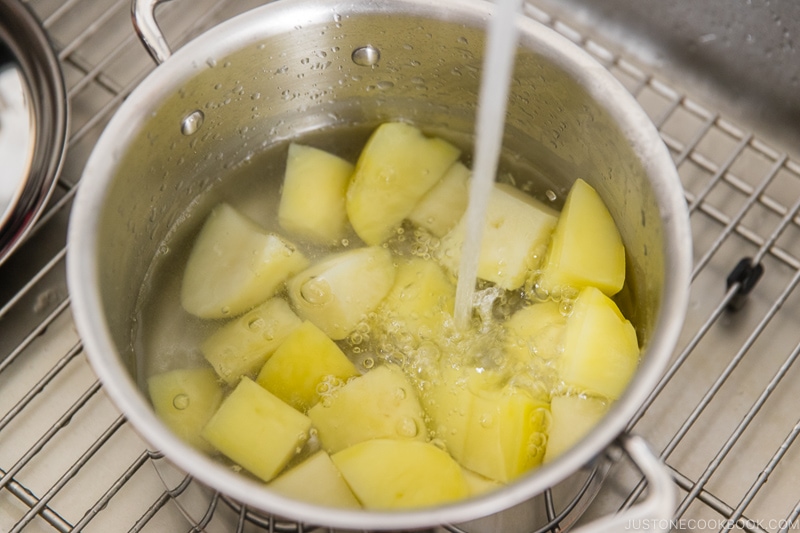
I used to make Japanese croquettes with my mom when I was growing up, so I knew we had to soak and rinse the potatoes with cold water before cooking to remove excess starch.
What I didn’t know until recently is that you can also rinse the potatoes AFTER cooking. As J. Kenji López-Alt explains in his book The Food Lab (which Mr. JOC and I love for its cooking science references), after draining the water, quickly rinsing boiled potatoes with hot water removes even more starch. To my surprise, I found that this trick really improved the texture of my mashed potatoes.
5. Dry Up Potatoes

Russets are higher in starch than Yukon Golds, which means they absorb water more easily. To avoid excess starch and moisture, you can do the following steps:
- Rinse the potatoes before and after boiling.
- Dry the potatoes properly to let moisture evaporate before mashing.
I’ll show you how to do it in the recipe card—it’s super easy! No one wants soggy mashed potatoes!
6. Use Good Old Potato Masher or Ricer
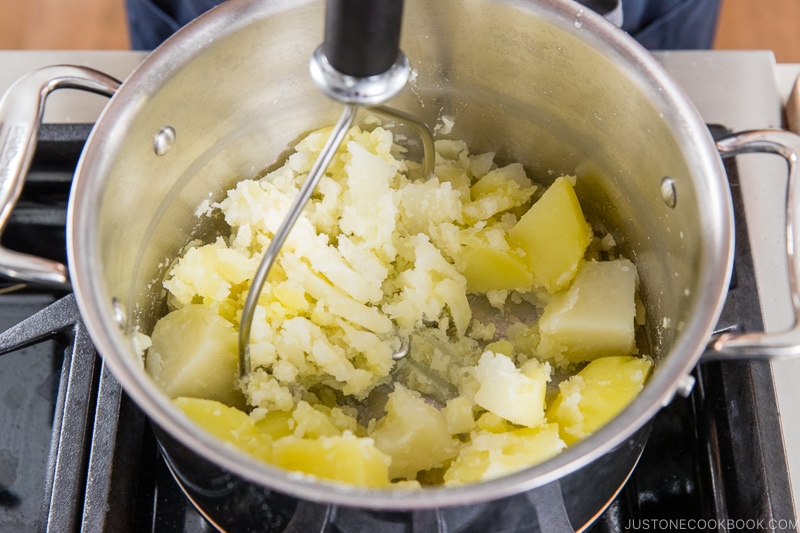
A ricer is probably the best tool for making mashed potatoes, but not everyone has one. The next best option is a good old potato masher (I use this brand). Don’t use a blender, food processor, or electric mixer.
7. Warm the Butter and Cream

Heat the butter, cream, and Shio Koji in a saucepan before adding them to the mashed potatoes. This helps the potatoes absorb the ingredients more easily, especially while they’re warm. Plus, you don’t want to lower the temperature of the mashed potatoes by adding cold ingredients!
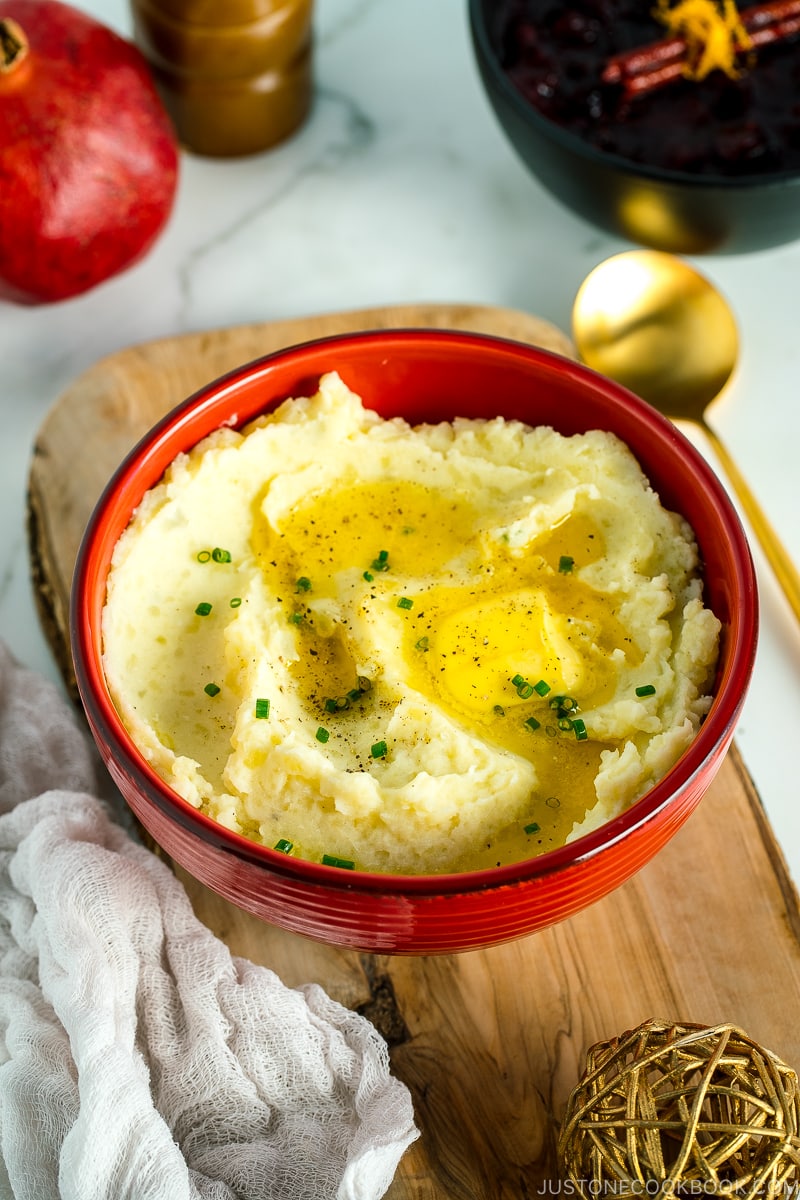
How to Store Mashed Potatoes
Mashed potatoes are freezer-friendly, so you can definitely make them ahead of time or save your leftovers for later. Be sure to coat the potatoes with butter and cream; the dairy and fat help keep them fresh and ensure they heat up nicely and remain creamy.
To store, you can either:
- Portion out the mashed potatoes using a cookie scoop onto a parchment-lined baking sheet. Freeze for at least a few hours or until solid. Then, transfer the individual servings to a large freezer bag or container and store them in the freezer.
- Transfer the cooled mashed potatoes directly to a container or large freezer bag and store them in the freezer.
You can choose to thaw the potatoes in the refrigerator a day before reheating to shorten the heating time, or you can reheat them directly from the freezer.
How to Reheat Mashed Potatoes
To reheat, there are a few choices, but below are my preferred methods:
- Microwave: Place a portion in a microwave-safe bowl, cover it, and microwave at 50 percent power for about 5 minutes, stirring occasionally, until heated through. The time may vary based on the amount of potatoes and your microwave wattage. Once heated through, stir well and add butter or seasoning as needed.
- Oven: Place the potatoes, thawed or straight from the freezer, in a covered casserole dish and bake at 350°F (180°C) for about 30 minutes, or until heated all the way through. Fluff and taste the potatoes. Add more butter, cream, and seasoning as needed.
What to Do with Leftover Mashed Potatoes?
If you’re tired of eating mashed potatoes, use them for these recipes!

Wish to learn more about Japanese cooking? Sign up for our free newsletter to receive cooking tips & recipe updates! And stay in touch with me on Facebook, Pinterest, YouTube, and Instagram.

Creamy Mashed Potatoes with Shio Koji
Ingredients
- 1½ lb russet and Yukon Gold potatoes (2 large potatoes should be about 1½ lb)
- 1 tsp Diamond Crystal kosher salt (for boiling the potatoes; use it if you do not use Shio Koji)
For the Seasonings
- 2 Tbsp unsalted butter
- ¼ cup heavy (whipping) cream
- 2 Tbsp shio koji (you can replace it with ½ tsp kosher/sea salt)
- freshly ground black pepper
For the Garnish
- 1 Tbsp unsalted butter
- a few stalks chives
- freshly ground black pepper
Instructions
- Gather all the ingredients.
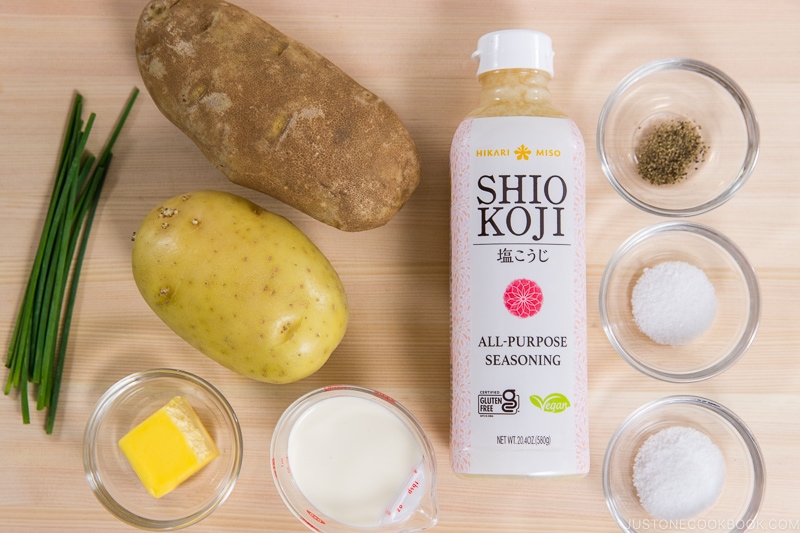
- Peel 1½ lb russet and Yukon Gold potatoes and remove the eyes.

- Cut each potato in half lengthwise and then cut into rough chunks, about 2-inch cubes.

- Transfer to a pot of cold water to soak for 2–3 minutes.

- Drain water and rinse the potatoes under cold running water. Use the lid of the pot to hold back the potatoes when draining.
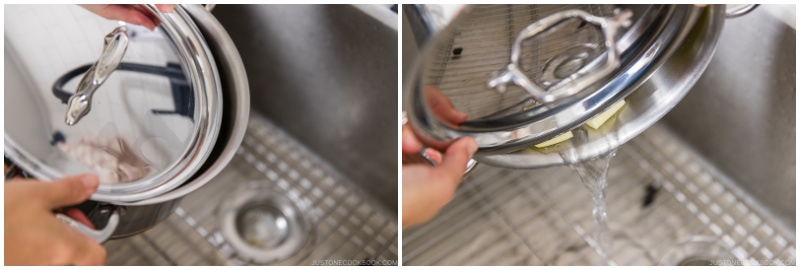
- Add cold water about 1 inch above the potatoes. If you are not using shio koji, sprinkle 1 tsp Diamond Crystal kosher salt into the water to season the potatoes. Put the lid on, leaving a small gap, and bring to a boil over medium-high heat (it’ll take about 10–15 minutes to boil).

- Once boiling, reduce the heat to medium (or even lower heat to maintain the boil). Cook the potatoes until tender, about 15 minutes (I usually cover the lid, slightly ajar, so water won‘t evaporate too fast.

- Meanwhile, in a saucepan, heat 2 Tbsp unsalted butter, ¼ cup heavy (whipping) cream, and 2 Tbsp shio koji over medium-low heat. Turn off the heat and set aside to keep warm (you may need to reheat before adding to the potatoes).

- When a skewer goes through the potato easily, turn off the heat. Drain the water completely.

- Rinse under hot running water and drain. Repeat 1–2 times to wash away the excess starch. Drain really well.
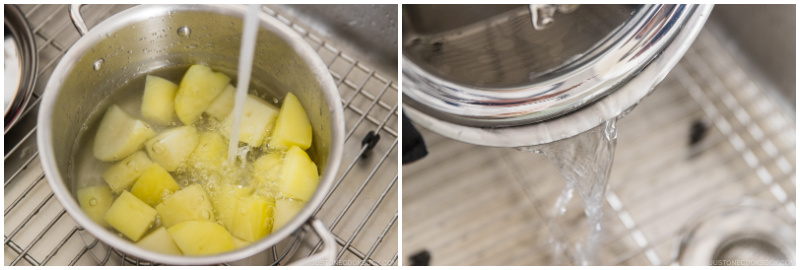
- Put the pot back on the stove and let them dry for a few minutes on low heat. With a stainless steel potato masher, mash the potatoes until you have a creamy and even mash.

- Pour the warm butter mixture over the mash and fold gently with a silicone spatula to combine.

- Season to taste with freshly ground black pepper and salt (if you are not using shio koji). Transfer to a serving bowl.

- Using a spoon to create grooves and top with 1 Tbsp unsalted butter, a few stalks chives (chopped), and more freshly ground black pepper. Enjoy!

To Store
- Mashed potatoes keep for 3 days in the refrigerator. You can also freeze them for a month in an airtight container or freezer bag.
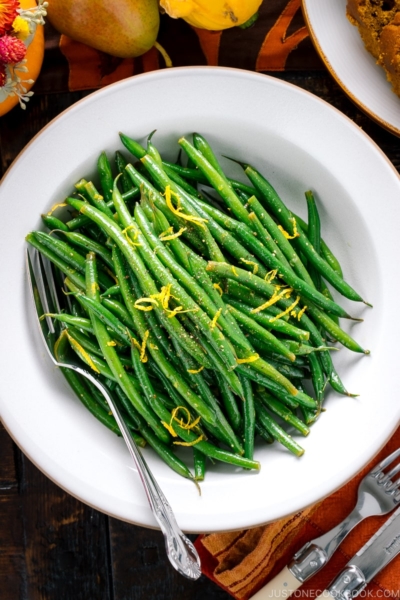







Thanks for the recipe. Especially helpful is the make ahead and freeze instructions, a life-saver for the hectic holiday meals. The kitchen and counters are always full. Happy Thanksgiving 🦃🍁!
Hi Karen! Happy Thanksgiving!
Thank you very much for trying Nami’s recipe and for your kind feedback!
We are glad to hear the recipe was helpful.🥰 We hope you enjoyed creamy mashed potatoes!
Mashed potato is going to be watery when Shiokoji is used as a seasoning. I believe that Enzyme in shiokoji causes this issue. It happens only on potatoes (so far in my shiokoji experience). Beans are good; even better with shiokoji like Humms.
I just read your comments for the ladies below! The solution is to get rid of starch and moisture, eh? After experiencing watery mashed potato, I gave up on using shiokoji. I never thought about washing it well after boiling! Thanks for your research!
Hi Yoko! Thank you very much for reading Nami’s post!
Yes! After Nami researched a bit further on this. We discover that the key is to get rid of the starch and moisture (Tip #4, rinsing before and after boiling potatoes AND tip #5, evaporating moisture).
We never had a soupy situation even once with this technic.
We hope this works for you too.
I made these and they were a great texture at first but about an hour later when we went to serve them, they had turned to soup. Do you think this is because of the shio koji? I’ve never had it happen before.
Hi Karlee,
Hum…. We don’t think this happens because of the Shio Koji.
Do you think some water was still in the pot after you let potatoes dry for a few minutes on low heat?
The same thing happened to me! It tasted delicious but completely turned to soup after letting it sit for 10min. We just poured it over the food like gravy and it was really tasty but no longer mashed potato consistency. I think maybe the enzymes in the shio koji breaks down the starches over time. I was using homemade shio koji from your recipe that had just reached two weeks old. I also doubled the recipe but otherwise followed it exactly. It was nice and fluffy after mixing in the shio koji. I left it covered for 10min while the rest of my meal was finishing cooking. When I served it, it had gone completely watery. I had to use a ladle to serve it. The flavor was delicious though.
Hi Karlee and Mei!
When I was testing the recipe, I had a similar issue once, so I know exactly what you two went through. I initially I thought the reason was Shio Koji, too. So I researched a bit further on this. It’s really important to get rid of the starch and moisture (Tip #4, rinsing before and after boiling potatoes AND tip #5, evaporating moisture).
After I ensured following these two tips, I never had the soupy situation even once. We eat the leftover on the second or sometimes third day, and the good texture remains perfectly. So I can guarantee that it’s nothing to do with Shio Koji.
This mashed potatoes are especially Mr. JOC’s favorite, and I actually make this exact recipe very often following my own recipe to the T (I usually proof read while I cook for my family). If you didn’t read the blog post, please re-read and make sure to follow tips. I never rinsed the boiled potatoes before (felt strange “rinsing” and I was doubtful haha), but it made a huge difference in my mashed potatoes and now I am a firm believer. 🙂
I received a Shio Koji (liquid) from Kokoro. It’s primarily for fish, because of Covid my husband can’t go to the office or a coffee shop when I cook fish. ( He really hates fish and the smell) Could I substitute the liquid for the dried in the mashed potatoes and, if so, how much should I use?
Hi Jennifer,
If you received Shio Koji from Kokoro Care Package (https://kokorocares.com/products/creative-beginnings-redefining-wa), it is not only for the fish, and you can use it for any ingredients (meat, fish, vegetables, and this mashed potatoes!).
I don’t think I fully understand your comment/question on “for the dried in the mashed potatoes.” Do you mean boxed “dried” mashed potatoes?